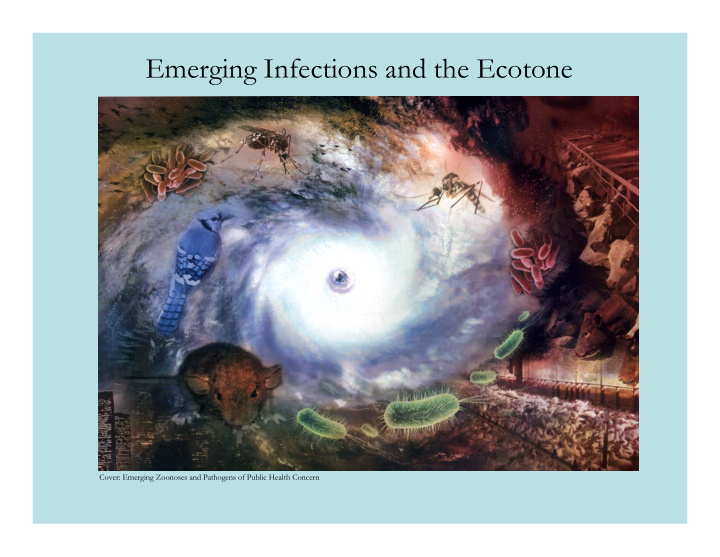



Emerging Infections and the Ecotone Cover: Emerging Zoonoses and Pathogens of Public Health Concern
To learn more, log on to: www.medicalecology.org
An ecotone is a narrow transition zone between one ecosystem and another.
From: Despommier & Wilcox. 2005 Ecohealth ( accepted for publication)
Environmental disturbance leads to emergence or establishment of infectious agents Urbanization: (encroachment into natural systems) Cholera Rabies Lyme Disease Arboviruses - Yellow Fever, Dengue Fever Ebola, Lassa, Hanta Plague African Sleeping Sickness
Cholera
Cholera Cholera Then and Now and Now Then John Sno w R ita Colwe lm
Distribution Of Estuaries
February 3 , 2 0 0 0 El Niño I ncreases Diarrheal Disease I ncidence by 2 0 0 Percent The El Niño phenomenon--the warming of the equatorial Pacific ocean that occurs every two to seven years--has been linked to outbreaks of dengue, malaria, and cholera. Now, researchers from the Johns Hopkins School of Public Health, A.B. Prisma, and the Instituto Nacional de Salud in Lima, Peru, have found that the 1997-1998 El Niño season increased hospitalizations for diarrheal disease by 200 percent, according to a study published in the February 5th issue of The Lancet . The results are cause for concern, said the researchers, since diarrhea already causes one billion episodes and three million deaths annually in children under five worldwide.
Trophic Relationships Of The Mangrove Estuary From: E. Odum Fundamentals Of Ecology
Ecology of Cholera Ecology of Cholera Numbers increase during monsoons due to phytoplankton blooms Filter-feeding Epidemics Epidemics Copepod crustacea Cholera bacteria Cholera bacteria Throw net fishing for crustacea after the monsoons in Bay of Bengal Fecal contamination of freshwater and human activities
Vibrio cholerae and its relatives are marine microbes, fully integrated into their respective food webs. Environmental conditions favoring growth of vibrio: 1. Low salt 2. High Nutrient Load Marine copepod with 3. 20 O C Vibrio cholerae attached to egg cases. Phytoplankton Bloom 4. Triggers phytoplankton bloom 5. Followed by zooplankton bloom 6. Followed by a cholera outbreak
Monsoons 1. lower the salinity of the estuary 2. bring nutrients to the estuary 3. raise the ambient water temperature of the estuary
Rabies Rabies
World Distribution of Rabies
Rabies vectors and carriers
B e lma B e lma L ugos i L ugos i : : P a ts on Saint o f P a ts on Saint o f Fruit Bats a lm bat specie s a lm bat specie s Nipah virus Did you know? Vampire Bat rabies virus 30% of all mammalian species are bats
ProMed: Oct 27th, 2005 From: Luciano Goldani <rsf4805@via-rs.net> Hematophagous (vampire) bats are proliferating because of forest devastation in the state of Maranhao, northeastern Brazil. 20 cases of fatal rabies have been clinically documented. The population in the area is protecting their houses with wire nets to prevent bat bites. Dr. Luciano Goldani Infectious Diseases Unit Universidade Federal do Rio Grande do Sul Brazil
Control of rabies by oral bait-vaccine
Thanks, Louie!
Yellow Fever Yellow Fever Walter Reed Distribution of Yellow Fever “A man, a plan, a canal. Panama”
P anama Canal: Ti e Early day s
Canopy Transmission Canopy Transmission By Haemogogus Haemogogus sp. sp. By
Ecology of Transmission Of Yellow Fever Ecotone
Occupations at High Risk Sugar cane Coffee Insurgent Rubber
Lassa fever
Lyme Disease Ixodes scapularis Borrelia burgdorferi
Lyme Disease Maintenance: Urbanization and De-forestation
Westchester County, NY
African Trypanosomiasis
East African Savanna
West African River
Riverine Tsetse and agriculture
Civil Unrest and War - 2005 Liberia Côte-d’Ivoire Sudan Cases - 400,000/yr - 400,000/yr Cases Ethiopia Deaths - 60,000/yr - 60,000/yr Deaths Nigeria Sierra Leone Guinea Ghana Burundi Burkina Faso Refugees Cameroon Gambia Rwanda Swaziland Mauritania Zambia Central African Republic Namibia Democratic Republic of Congo
Leishmaniasis Leishmaniasis
Rodent Holes and Sandfly Habitat
Reservoir Hosts
Encroachment and Vector-borne Diseases
Occupations at Risk Sugar cane Rubber Coffee
Malaria
Some Important Vectors Anopheles dirus Anopheles gambia Anopheles balabacensis
Oasis habitat
Marsh habitat
Irrigation Canal Habitat
Swampland Habitat
Rice Paddy Habitat
What’s Next?
Without an ecological perspective on infectious disease transmission, its anyone’s guess! Us Infectious diseases
Recommend
More recommend